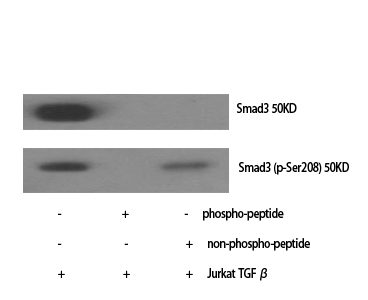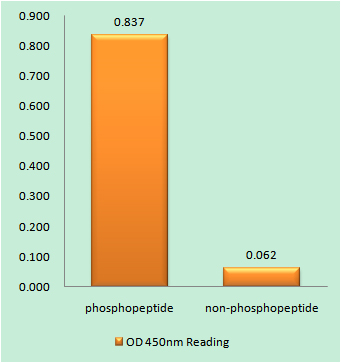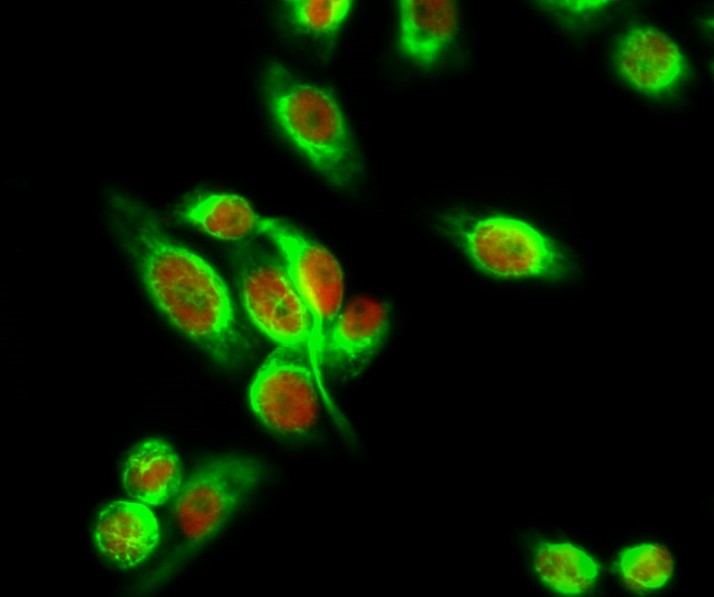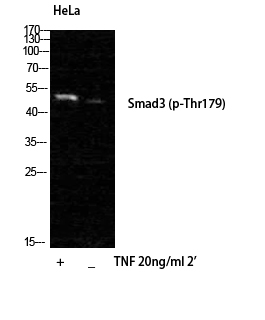Smad3 (phospho Ser208) Polyclonal Antibody
- Catalog No.:YP0746
- Applications:WB;IHC;IF;ELISA
- Reactivity:Human;Mouse;Rat
- Target:
- Smad3
- Fields:
- >>FoxO signaling pathway;>>Cell cycle;>>Endocytosis;>>Cellular senescence;>>Wnt signaling pathway;>>TGF-beta signaling pathway;>>Apelin signaling pathway;>>Hippo signaling pathway;>>Adherens junction;>>Signaling pathways regulating pluripotency of stem cells;>>Th17 cell differentiation;>>AGE-RAGE signaling pathway in diabetic complications;>>Hepatitis B;>>Human T-cell leukemia virus 1 infection;>>Pathways in cancer;>>Colorectal cancer;>>Pancreatic cancer;>>Chronic myeloid leukemia;>>Hepatocellular carcinoma;>>Gastric cancer;>>Inflammatory bowel disease;>>Diabetic cardiomyopathy
- Gene Name:
- SMAD3
- Protein Name:
- Mothers against decapentaplegic homolog 3
- Human Gene Id:
- 4088
- Human Swiss Prot No:
- P84022
- Mouse Gene Id:
- 17127
- Mouse Swiss Prot No:
- Q8BUN5
- Rat Gene Id:
- 25631
- Rat Swiss Prot No:
- P84025
- Immunogen:
- The antiserum was produced against synthesized peptide derived from human Smad3 around the phosphorylation site of Ser208. AA range:174-223
- Specificity:
- Phospho-Smad3 (S208) Polyclonal Antibody detects endogenous levels of Smad3 protein only when phosphorylated at S208.
- Formulation:
- Liquid in PBS containing 50% glycerol, 0.5% BSA and 0.02% sodium azide.
- Source:
- Polyclonal, Rabbit,IgG
- Dilution:
- WB 1:500 - 1:2000. IHC 1:100 - 1:300. ELISA: 1:10000.. IF 1:50-200
- Purification:
- The antibody was affinity-purified from rabbit antiserum by affinity-chromatography using epitope-specific immunogen.
- Concentration:
- 1 mg/ml
- Storage Stability:
- -15°C to -25°C/1 year(Do not lower than -25°C)
- Other Name:
- SMAD3;MADH3;Mothers against decapentaplegic homolog 3;MAD homolog 3;Mad3;Mothers against DPP homolog 3;hMAD-3;JV15-2;SMAD family member 3;SMAD 3;Smad3;hSMAD3
- Observed Band(KD):
- 40kD
- Background:
- The protein encoded by this gene belongs to the SMAD, a family of proteins similar to the gene products of the Drosophila gene 'mothers against decapentaplegic' (Mad) and the C. elegans gene Sma. SMAD proteins are signal transducers and transcriptional modulators that mediate multiple signaling pathways. This protein functions as a transcriptional modulator activated by transforming growth factor-beta and is thought to play a role in the regulation of carcinogenesis. [provided by RefSeq, Apr 2009],
- Function:
- disease:Defects in SMAD3 may be a cause of colorectal cancer (CRC) [MIM:114500].,domain:The MH2 domain is sufficient to carry protein nuclear export.,function:Transcriptional modulator activated by TGF-beta (transforming growth factor) and activin type 1 receptor kinase. SMAD3 is a receptor-regulated SMAD (R-SMAD).,PTM:Phosphorylated on serine by TGF-beta and activin type 1 receptor kinases.,similarity:Belongs to the dwarfin/SMAD family.,similarity:Contains 1 MH1 (MAD homology 1) domain.,similarity:Contains 1 MH2 (MAD homology 2) domain.,subcellular location:In the cytoplasm in the absence of ligand. Migration to the nucleus when complexed with Smad4.,subunit:Interacts with HGS. Interacts with NEDD4L in response to TGF-beta. Interacts with TTRAP (By similarity). Interacts with SARA (SMAD anchor for receptor activation); form trimers with another SMAD3 and the co-SMAD SMAD4. Interacts wit
- Subcellular Location:
- Cytoplasm . Nucleus . Cytoplasmic and nuclear in the absence of TGF-beta. On TGF-beta stimulation, migrates to the nucleus when complexed with SMAD4 (PubMed:15799969, PubMed:21145499). Through the action of the phosphatase PPM1A, released from the SMAD2/SMAD4 complex, and exported out of the nucleus by interaction with RANBP1 (PubMed:16751101, PubMed:19289081). Co-localizes with LEMD3 at the nucleus inner membrane (PubMed:15601644). MAPK-mediated phosphorylation appears to have no effect on nuclear import (PubMed:19218245). PDPK1 prevents its nuclear translocation in response to TGF-beta (PubMed:17327236). Localized mainly to the nucleus in the early stages of embryo development with expression becoming evident in the cytoplasm of the inner cell mass at the blastocyst stage (By similarity)
- Expression:
- Brain,Colon carcinoma,Esophagus tumor,Pancreas,Placenta,Spleen,Umbilical cord blood
- June 19-2018
- WESTERN IMMUNOBLOTTING PROTOCOL
- June 19-2018
- IMMUNOHISTOCHEMISTRY-PARAFFIN PROTOCOL
- June 19-2018
- IMMUNOFLUORESCENCE PROTOCOL
- September 08-2020
- FLOW-CYTOMEYRT-PROTOCOL
- May 20-2022
- Cell-Based ELISA│解您多样本WB检测之困扰
- July 13-2018
- CELL-BASED-ELISA-PROTOCOL-FOR-ACETYL-PROTEIN
- July 13-2018
- CELL-BASED-ELISA-PROTOCOL-FOR-PHOSPHO-PROTEIN
- July 13-2018
- Antibody-FAQs
- Products Images

- Western Blot analysis of various cells using Phospho-Smad3 (S208) Polyclonal Antibody
.jpg)
- Western Blot analysis of Jurkat cells using Phospho-Smad3 (S208) Polyclonal Antibody

- Enzyme-Linked Immunosorbent Assay (Phospho-ELISA) for Immunogen Phosphopeptide (Phospho-left) and Non-Phosphopeptide (Phospho-right), using Smad3 (Phospho-Ser208) Antibody

- Immunohistochemistry analysis of paraffin-embedded human colon carcinoma, using Smad3 (Phospho-Ser208) Antibody. The picture on the right is blocked with the phospho peptide.


